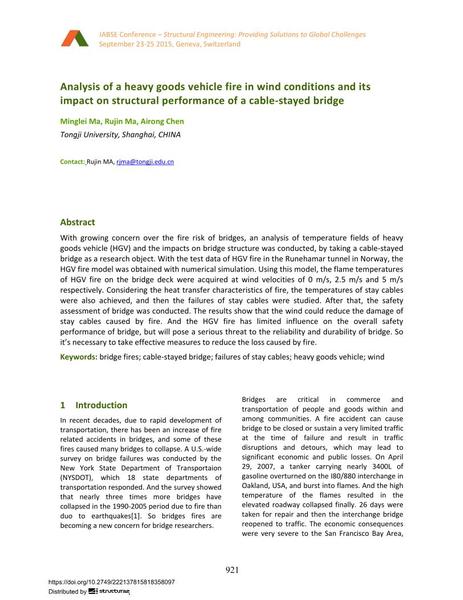Analysis of a heavy goods vehicle fire in wind conditions and its impact on structural performance of a cable-stayed bridge

|
|
|||||||||||
Bibliografische Angaben
| Autor(en): |
Rujin Ma
(Tongji University, Shanghai, China)
Minglei Ma (Tongji University, Shanghai, CHINA) Airong Chen (Tongji University, Shanghai, China) |
||||
|---|---|---|---|---|---|
| Medium: | Tagungsbeitrag | ||||
| Sprache(n): | Englisch | ||||
| Tagung: | IABSE Conference: Structural Engineering: Providing Solutions to Global Challenges, Geneva, Switzerland, September 2015 | ||||
| Veröffentlicht in: | IABSE Conference Geneva 2015 | ||||
|
|||||
| Seite(n): | 921-928 | ||||
| Anzahl der Seiten (im PDF): | 8 | ||||
| Jahr: | 2015 | ||||
| DOI: | 10.2749/222137815818358097 | ||||
| Abstrakt: |
With growing concern over the fire risk of bridges, an analysis of temperature fields of heavy goods vehicle (HGV) and the impacts on bridge structure was conducted, by taking a cable-stayed bridge as a research object. With the test data of HGV fire in the Runehamar tunnel in Norway, the HGV fire model was obtained with numerical simulation. Using this model, the flame temperatures of HGV fire on the bridge deck were acquired at wind velocities of 0 m/s, 2.5 m/s and 5 m/s respectively. Considering the heat transfer characteristics of fire, the temperatures of stay cables were also achieved, and then the failures of stay cables were studied. After that, the safety assessment of bridge was conducted. The results show that the wind could reduce the damage of stay cables caused by fire. And the HGV fire has limited influence on the overall safety performance of bridge, but will pose a serious threat to the reliability and durability of bridge. So it’s necessary to take effective measures to reduce the loss caused by fire. |
||||
| Stichwörter: |
Wind Schrägseilbrücke
|
||||
